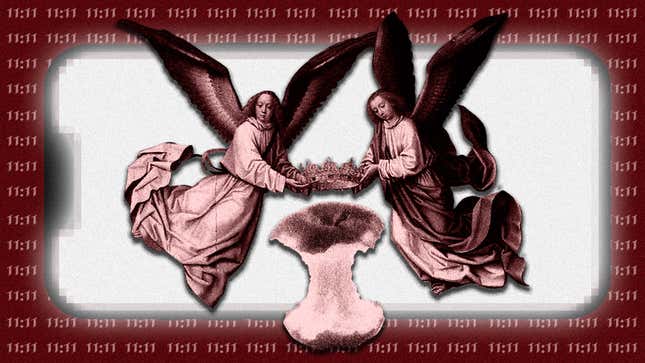A Sin to Eat: The Untold Story of Anorexia as Religion
It started with medieval “fasting girls.” Now, divine devotion and the occult mingle in eating disorder communities online.
In DepthIn Depth
Illustration: by Jezebel
Every day, Amelia sets an alarm for 11:11 a.m. “Prayer Time” her phone beeps, alongside an angel emoji. Every day, the prayer is the same: “Please let me make it through the day without binging.” Amelia (not her real name; she wishes to remain anonymous), explains that 11, which resonates at a superlatively high vibration, is said to represent transformation. It is her favorite angel number.
Amelia first learned about angel numbers—a branch of numerology in which repetitive number sets convey a divine message from the universe—on a Twitter thread, from an account that gives instructions on how to “look like a Victoria’s Secret model from 2010” using dietary as well as spiritual practices. Under each thread, numerous users with variations of angel numbers in their usernames express their gratitude. “I also watch a lot of subliminals,” Amelia says. With titles like “*・῾ ✧.* + subliminal,” these pseudoscientific YouTube videos tend to follow a generic formula: montages of skinny white women alongside affirmations between the muted beats of a Lana Del Rey song. They purportedly rewire the subconsciousness, like an external agent whispering “eat less, exercise more” straight to the brain cells. Many reliably amass over a million views.
On TikTok, Amelia’s algorithm is dominated by “what I eat in a day” food diaries, and potions and angel number spells for weight loss: One witch, who addresses her viewers as “spiritual baddies,” advises they wait for a full moon before combining turmeric, cayenne pepper, and ginger, and repeating, “I will release myself of what no longer serves me.” The weight loss spell, this witch says, is her second most requested spell (the first is a spell for love).
Amelia is living out her early twenties at a time when pro-skinny social media content is cause for censorship, and eating disorder-related hospitalizations are reportedly on the rise among adolescents. At the same time, New York podcasters canvas the virtues of skinniness in ketamine drawls, while the Y2K fashion revival inspires commentators to affirm that “thin is in again.” She’s in a double-bind. As a young woman, she’s taught that her alignment with today’s beauty ideals grants her attention, affection, and envy. Yet she’s also reprimanded for taking that lesson in earnest, as journalists, parents, and online commentators tend to place the blame on individuals like her for reinforcing “painfully skinny” waif girl ideals, without offering any empathy for why she might need to pursue skinniness as her life’s ultimate meaning in the first place.
“It’s not about some skinny waif TikTok aesthetic,” Amelia says, refuting anyone who might misunderstand her goals. “I want to be skinny so I can feel like an ethereal angel. If I can make it through the day without binging, then I can be pure and good. It’s almost like my own religion.” So into the world of subliminals, pro-anorexia hashtags, and angel numbers Amelia escaped to worship among those who do understand her.
You’ll encounter plenty of people like Amelia across TikTok, Instagram, and Twitter, who use thinspirational saints like Alana Champion in their display photos and angel numbers in their handles. They are largely anti-recovery, and speak self-deprecatingly about their illness (though they don’t refer to it as such). This devotion to skinniness isn’t unique to their generation; there exists a near-ancient relationship between spirituality, religion, and disordered eating. Amelia’s world fits into a remarkably linear history—from Eve’s biting of the apple to the very first online forums—through which the spiritual and religious have commingled with the desire to be eminently thin.
The fall of mankind began with a woman eating. The first recorded anorexics came later, in the 13th century, at a time when starvation was held in high and holy regard, and abstinence from appetite was considered atonement for the fall of man.
Holy anorexia, a term coined by historian Rudolph Bell, of this kind was both a pursuit of autonomy as well as a way to embody the suffering and religious mortification of Christ. While men tended to express their religiosity through poverty, in this medieval mindset, women saints—who Bell also referred to as the “fasting girls” in his 1985 book on the subject—could only hope to achieve holiness by rejecting their bodily, biological needs. Eventually, this would lead to a premature death that, as Bell argued, allowed women to avoid a life of marriage, child rearing, and domesticity. It was also a transcendent reward for their suffering.
-

-

-

-

-

-

-

-

-

-

-

-

-

-

-

-

-

-

-

-

-

-

-

-

-

-

-

-

-

-

-

-

-

-

-

-

-

-

-

-








































